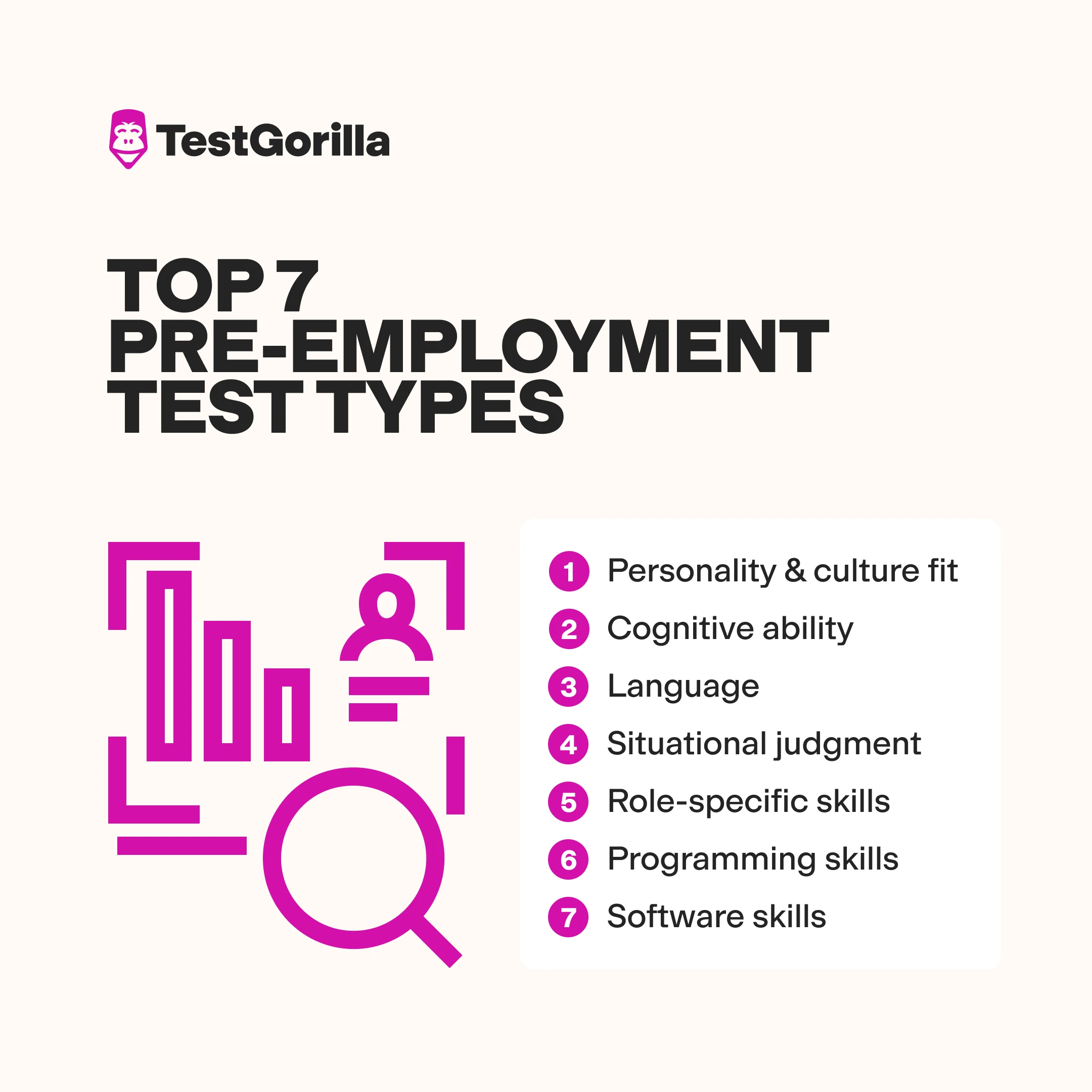The 7 test types you need for a strong pre-employment assessment
Explore the essential test types for effective skills assessments
Screening CVs must be one of the most ineffective ways to find good candidates for your open roles. There’s no standard format, candidates can exaggerate (while others may be too humble for their own good), and your eyes glaze over after the 10th bullet point.
A better way to screen candidates? Pre-employment assessments.
Pre-employment assessments test all your candidates across the same parameters. They help you quantify their expertise in the skills that matter most to your open role. And they rank them on the same scale so you can understand who excels when compared to others.
By combining various (and relevant) test types in ready-made assessments to send out in bulk, you can start gathering richer insight on your candidates’ profiles.
In this article, we’ll help you jump through the hoops of understanding the benefits of an assessment, the types of tests that are most relevant to your candidates, and what the final result should look like (i.e. the order in which you should layout tests in your assessment).
Why are pre-employment assessments so beneficial?
Pre-employment assessments can help you guide your hiring decisions while reducing costs associated with employee turnover by increasing their overall satisfaction. You can use them alongside recruiting automation tools.
Test recruitment is also a great way to measure the likelihood of a candidate to succeed in your role of interest by comparing their results across different test types.
Some of the key benefits include:
A clear picture of who the top candidates are among your applicants, saving you time and a few headaches during the hiring process while providing rich insights on their skills and aptitude;
Enhanced productivity thanks to a streamlined process that ditches CVs in favor of a standardized assessment format. These assessments can be sent to multiple candidates at a time and are usually completed in as little as a few days;
Increase in employee retention as well as reductions in costs related to employee turnover, saving organizations money in the long-term. Candidates who score well in pre-employment assessments are more likely to be a good fit and stay longer.
According to Aberdeen Group, businesses that use pre-employment assessments are 36% more likely to be satisfied with their new hires compared to those who don’t.
Armed with the insights pre-employment assessments offer, you’ll be able to make better and more objective hiring decisions. This is the key advantage of using standardized assessments versus scrambling to find that one CV that seemed like a good fit.
What’s the difference between a test and an assessment?
Pre-employment tests and assessments are two separate but related things. When used together, they form the ideal solution to capture relevant, data-driven insight from your candidates and choose whether they are the ideal fit for your vacancy.
What is a pre-employment test?
A pre-employment test consists of a series of text-based or media-led questions or challenges that test a candidate’s expertise in a specific skill. It covers 3-4 skill areas and it’s comprehensive for that one skillset.
Tests usually last around 10 minutes, giving the candidate just enough time to answer the questions and move on to the next test. This is done on purpose to give the candidate a sense of urgency and help them move forward in the assessment. You can think of tests as the “building blocks” to a strong pre-employment assessment.
What is a pre-employment assessment?
A pre-employment assessment combines several tests to offer you a full spectrum of insights around your candidates. The ultimate goal of an assessment is to help you hire the right person for the role. Everything else is secondary. To do this, assessments should be kept standardized and sent out to candidates in bulk for a quick comparison.
Our pre-employment assessments at TestGorilla combine three important components to help you make the best hiring decisions:
The premade tests themselves: include up to five tests in an assessment for a well-rounded review of your candidate’s profile;
The custom questions (optional): add up to 10 personalized questions to your assessment (multiple-choice, open-ended or media-led);
The candidate performance score: measure which candidate performed better than others based on their answers to the questions provided.
Thanks to these three components, candidate screening assessments (and the tests therein) can hugely benefit the pre-hire process by allowing for richer candidate insight compared to traditional CV or resume screening. They also have the benefit of being more predictive of success than resume screening software.
Master skills testing with varied test types
Delve into the variety of skills tests we offer. Sign up for our free live demo to see how diverse assessments can enhance your hiring process.
The best insights on HR and recruitment, delivered to your inbox.
Biweekly updates. No spam. Unsubscribe any time.
7 test types to consider for your next assessment
There are various types of tests you can use in your assessment to measure candidates on soft skills such as cognitive ability, personality, situational judgment, as well as hard skills such as role-specific skills (accountant, web developer, etc.), programming knowledge, software proficiency, and more.
While tests themselves are the foundational units of a strong assessment, the different test types can help provide a fuller picture of the candidate’s profile.
Each test type focuses on one aspect of a candidates’ overall profile and mixing test types in your pre-employment assessment helps extrapolate the data necessary to make a better hiring decision. At TestGorilla, we’ve grouped tests into seven types to help you create more comprehensive assessments.
Note: If you’re curious to learn more about a specific test type, you can browse our test library and choose one of the options from the dropdown menu in the top-right corner.
For each individual test, you can also explore a few sample questions to help you understand the contents and whether they’re a good fit for your next assessment.
Test type 1: personality and culture fit
A personality test measures the characteristics an individual exhibits in the way they behave. As the name suggests, personality and culture fit tests are meant to explore the candidate’s personality traits and ensure fit within the company culture.
The definition holds especially true in a business environment where using personality tests can shine light on the way candidates behave as well as uncover their psychological traits. This can mean the difference between hiring someone who thrives at your workplace and someone who finds struggles to keep up.
An example of a personality test is the 16 Types test. This test gives insight into the candidate’s source of energy, the way they process information, how they make decisions, and the kind of lifestyle they prefer.
The end goal is to generate a trait profile of your candidate by asking questions that are based on various personality dimensions. Adding this test to your pre-employment assessment will help you better understand your candidate’s potential for job performance and satisfaction within certain aspects of your open role.
Test type 2: cognitive ability
Cognitive ability tests differ from personality tests as they are meant to assess abilities around thinking (reasoning, problem solving, verbal ability, etc.)
While these tests aren’t as specific as technical tests (which involve knowledge of a specific subject), they are significantly more challenging than personality tests.
The end goal of a cognitive ability test is to assess the candidate’s potential to use mental processes when dealing with problems in the workplace.
Two notable examples are:
Problem Solving, a test that is meant to check if a candidate knows how to address scheduling conflicts, properly store or display items in order, and make informed decisions based on available data.
Numerical Reasoning, a test that measures the candidate’s ability to use logic-based reasoning: the thought process and problem solving derived from mathematical problems applied to the real world.
Cognitive ability tests measure “intelligence” or “general mental ability.” The main benefit of measuring this trait in your pre-employment assessment is to understand candidates’ capacity for dealing with challenging mental processes successfully.
In total, TestGorilla, currently has six different cognitive ability tests that measure candidates on their:
Test type 3: language
Language tests measure a candidate’s proficiency with a specific language based on the Common European Framework of Reference for Languages, or CEFR in short. While born in Europe, this framework is now used internationally.
Language tests are usually catered specifically to a candidate based on the required proficiency level, from beginner (A1) to native or bilingual (C2).
Two examples of language tests could be:
English (Intermediate/B1), used mainly to gauge basic business English proficiency for foreign speakers who are working abroad;
Mandarin (Proficient/C1), used in specific roles that require Mandarin language proficiency due to business travel or communication needs.
Checking language skills in your pre-employment assessment helps you understand whether your candidates have the required language skills (grammar, business jargon, etc.) for the job before inviting them for an extensive interview.
Test type 4: situational judgment
Situational judgment tests contain descriptions on a specific situation that are immediately followed by a question on how to handle it properly (usually around risk, stress, ethics, and other business factors).
As the name suggests, these are meant to measure the candidate’s situational judgment and how they would make decisions within specific contexts. Situational Judgment tests are particularly effective for managerial and leadership requirements.
Two notable situational judgment test examples are:
Business Ethics & Compliance, evaluating a candidate’s awareness, judgment, and knowledge of ethical issues in business settings.
Negotiation, helping with the identification of candidates who display a capacity to control and drive a discussion by negotiating effectively.
Situational judgment tests play an important role in pre-employment assessments because they help you understand whether a candidate can apply theoretical knowledge to work-related contexts to achieve the desired outcomes.
Test type 5: role-specific skills
Tests that measure role-specific skills are directly targeted at the candidates’ role of choice and they are meant to uncover whether they can get the job done or not. They tend to be more technical and knowledge-based than previously discussed test types, especially when specific to an industry or niche.
With questions that are meant to prove professional expertise in specific knowledge areas, role-specific tests evaluate how much a candidate knows around a professional topic.
Two examples from our test gallery are:
Customer Service, a test meant to evaluate a candidate’s overall customer service aptitude (including general customer psychology) and a basic understanding of customer service best practices.
Advanced Accounting, a test specific to accounting roles, evaluates candidates’ accounting knowledge, including posting and calculating accounting figures and managing financial records according to GAAP. It helps identify candidates with strong accounting/bookkeeping skills. While the two examples provided are easily recognizable role-wise, these tests can go as specific as they need to based on the technical requirements.
One of the key advantages of role-specific tests is the immediate understanding of whether a candidate truly spent time on learning about (and practicing) it in the past. And the best time to shine a light on the body of knowledge the candidate possesses on a professional topic is during a pre-employment assessment.
Test type 6: programming skills
Going deeper into technical knowledge, programming skills have now become a staple of modern business and innovation. With programming languages and frameworks using their own rules, it makes sense to have tests for each.
Similar to role-specific skills, tests on programming skills are meant to identify whether the candidate has the knowledge required for the vacancy on a specific topic. These should always be combined with more general tests.
Two of the most popular programming tests are:
HTML5, testing the candidate’s ability to apply knowledge of this markup language in the development of websites and web applications.
PHP, a test where candidates demonstrate their coding skills by performing small coding assignments to meet requirements.
Tests in the programming space can last longer than the usual 10 minutes due to the complexity of coding requirements. Questions and challenges can vary from technical knowledge to problem solving and are usually complemented by screenshots or images to help the candidate visualize the issue at hand. Naturally, this type of test is indispensable for pre-employments assessments for programmers.
Optimize your hiring with TestGorilla
Discover how our range of tests improves candidate screening. Join TestGorilla's free plan to access varied assessments for better hiring decisions.
Optimize your hiring with TestGorilla
Discover how our range of tests improves candidate screening. Join TestGorilla's free plan to access varied assessments for better hiring decisions.
Test type 7: software skills
Similar to programming skills but geared towards productivity and proprietary platforms, software skill testing is another important type to consider when evaluating your candidate’s ability to adapt to your business environment.
Tests in this area range anywhere from cloud CRM solutions such as Salesforce, HubSpot, and Zendesk to more traditional programs and skills such as MS Word, MS Excel, and email productivity suites (mostly Outlook and Gmail).
Two further options from the advertising world are:
Facebook Advertising, evaluating a candidate’s knowledge in setting up and managing Facebook advertising campaigns that deliver ROI;
Google Ads, a test focusing on the candidate’s understanding of why and when certain features should be used within Google Ads.
Modern software comprises many different functions that aren’t as immediate as most candidates like to think (Excel is a prime example of this!). Asking the right questions from the get-go is not only a big time saver but also a key indicator of how fast the candidate will adapt to your working environment once they’re eventually hired.
Our recommendation is to mix test types in your pre-employment assessments based on both the vacancy requirements and the ideal candidate profile. As we’ll see in just a moment, there is no “perfect” assessment but there is a basic framework to begin with.
Creating balanced pre-employment assessments for richer insights
It’s hard to garner the true potential of a candidate with just one test or even multiple tests in the same domain. You want to diversify your assessments.
By doing so, you’re getting a clearer understanding of your candidates’ profiles when put against one another. It’s not just about hard skills—soft skills are just as important.
Employing a wider set of tests means you’re going deeper than most recruiters would and you’re extrapolating the data that’s central to making a strong hiring decision.
Start with a personality or culture fit test
It’s always smart to start your assessments with a personality or culture fit test. While some candidates may excel in technical areas, you also want to make sure they have a matching work ethic compared to their future coworkers.
Starting your assessments with a personality or culture fit test also eases the pressure on the candidate as they are greeted with questions that feel more casual while still providing an objective view on their profile.
Find a combination that works for your candidates
The perfect combination of test types doesn’t exist. At TestGorilla, we recommend that you always include the following types:
Include at least one role-specific test after the personality test (you should add more than one in case the role involves multiple responsibilities);
Add one test on cognitive ability and another test on situational judgment to form a full picture of the candidate in-between role-specific tests.
By including the test types in this order, your candidates are more likely not only to complete the assessment but also to feel more at ease while doing so.
End with a few custom questions
Ending your assessments with a few custom questions such as “Why do you want to work for us?” or “What made you consider sending an application for this vacancy?” can provide further insight on the motivations of an individual.
This is particularly important if your company has rules of conduct or business ethos that doesn’t match with your candidate’s view. You want to extrapolate this data in advance to ensure the perfect fit for your brand, not just your culture. With this basic framework, you can start creating your own pre-employment assessment.
Hire the best people with a standardized assessment
Choosing the right test types for your next pre-employment assessment can make the difference between an employee that delivers value to your organization for years and one that pulls everyone in the team to a halt. The goal of using multiple test types is to gather rich candidate insights and drive your decision based on facts, not gut-feel.
When choosing test types for your next assessment, consider including a variety of them. It’s fairly common to underestimate soft skills—especially if the open role is a technical one—but gathering data around a candidate’s business (and sometimes personal) motivations will help you guide your hiring decisions much faster.
Using a standardized approach like pre-employment skills testing is not only a huge time saver but also a big value-add to the company. Thanks to a streamlined process that puts valuable insight at the forefront, you’ll be able to better track and demonstrate why that one employee you helped hire plans to stick around for years to come.
You can browse our test library for more tests in each type and start creating your own assessment today with our free plan.
You've scrolled this far
Why not try TestGorilla for free, and see what happens when you put skills first.






















